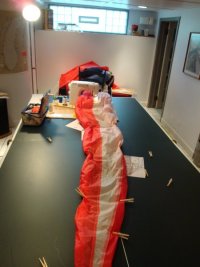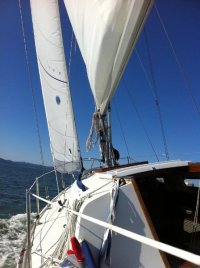Getting more serious about a new genny to replace the '95 dacron 135% furler.
Had a chat with the local North rep yesterday. He can quote price but could not comment on just how much % would be minimally enough for my boat. The good news is that our boat is very easily driven.
My goal is a lighter-weight sail that will take a decent shape on 5 to 8 kt days and have good pointing and drive in 10 to 14 kt true.
Stated additional goal is to bring the % down to maybe 120 or 125. A modern composite material will reduce the weight aloft a lot, as well.
We do sail in 20 to 24 kt true once a while, but by then we've rolled in some sail, too.
It's interesting in this centralized sailing production age that we live in that he wants me to sort of place an order, at least on paper, so their main office can generate a specific sail design.
While the North guy has a nice facility that can do in-house repairs and mods, his bidding expertise seems to only be about one click further up than that of my friend that has been the local Lee Sails rep for 20 years.
He does admit that North, in their effort to satisfy every niche of the market, has a near-bewildering array of cloth and construction choices these days. The actual construction is done at a centralized North Sails facility in SE Asia.
I left there a bit puzzled. No, not upset or agitated, just uncertain...
The paper quote for a nominal 130%, in their "Marathon series 300" (about 383 sq ft) is $3956. with current winter discount down to $3362.
The lack of decisiveness on his part might mean that he's more used to dealing with sailors with both more money and more expertise right up front.
Anyone with a 34 or a 911S having a comment about a good real-world compromise for overlap, please do chime in!
I should note that pursuing a rating break is NOT part of this calculation.
Regards,
Loren
Had a chat with the local North rep yesterday. He can quote price but could not comment on just how much % would be minimally enough for my boat. The good news is that our boat is very easily driven.
My goal is a lighter-weight sail that will take a decent shape on 5 to 8 kt days and have good pointing and drive in 10 to 14 kt true.
Stated additional goal is to bring the % down to maybe 120 or 125. A modern composite material will reduce the weight aloft a lot, as well.
We do sail in 20 to 24 kt true once a while, but by then we've rolled in some sail, too.
It's interesting in this centralized sailing production age that we live in that he wants me to sort of place an order, at least on paper, so their main office can generate a specific sail design.
While the North guy has a nice facility that can do in-house repairs and mods, his bidding expertise seems to only be about one click further up than that of my friend that has been the local Lee Sails rep for 20 years.
He does admit that North, in their effort to satisfy every niche of the market, has a near-bewildering array of cloth and construction choices these days. The actual construction is done at a centralized North Sails facility in SE Asia.
I left there a bit puzzled. No, not upset or agitated, just uncertain...
The paper quote for a nominal 130%, in their "Marathon series 300" (about 383 sq ft) is $3956. with current winter discount down to $3362.
The lack of decisiveness on his part might mean that he's more used to dealing with sailors with both more money and more expertise right up front.
Anyone with a 34 or a 911S having a comment about a good real-world compromise for overlap, please do chime in!
I should note that pursuing a rating break is NOT part of this calculation.
Regards,
Loren

 It can't hurt to give them a shout. No affiliation, just a really good experience.
It can't hurt to give them a shout. No affiliation, just a really good experience.


